

Almost all Maryland caves are on private or restricted property. Always ask permission from the cave owner to enter a cave. Many caves require rope work and rappelling skills, and explorers need to be in good physical condition. Make sure you are accompanied by an experienced caver and you are outfitted properly. Do not explore caves unless you know what you are doing, and never enter a cave alone. For information about caving, see the links below. Spelunking, the sport of cave exploring, is a popular hobby. Maryland caves have a rich natural and cultural history that requires careful preservation and study. More recently, some of these caves have been mined as a source of metal ores, and nitrates for gunpowder. In the past, aboriginal human populations used caves for shelter and religious ceremonies. Other animals including cave crickets and cave moths live primarily in the subterranean world. Caves offer refuge to these creatures when forests and farmland are destroyed and surface streams are diverted and polluted. These animals currently suffer from loss of habitat in Maryland due to development. Salamanders, wood rats and several types of bats are particularly attracted to caves. A variety of spiders, insects, amphibians, reptiles, fish and mammals make caves their seasonal or permanent homes. This kind of environment makes caverns an ideal habitat for many animals. The mild temperatures and high humidities found in most Maryland caves are relatively constant throughout the year. For more information on karst and karst terrane hazards, see MGS Factsheet 11: Foundation Engineering Problems and Hazards in Karst Terranes. Sinkholes can develop unexpectedly and rapidly, swallowing up cars, houses and whole towns. While visually interesting, karst topography can be a potential hazard. Sinking streams, sinkholes, and springs are often found in areas underlain by limestone. The landscape that develops over limestone and marble regions is often shaped by the same geochemical process that forms caves. These caves are probably less than 10 million years old A tight squeeze Therefore, most of Maryland's caves are found in those regions. Exposures of these rocks are limited to the central and western parts of the state. Maryland's caves occur mostly in limestone and marble. Over thousands of years, this process enlarges the voids and spaces in the limestone, forming caves.

This acidic water then filters down to the limestone bedrock where it flows through pores and joints. When rain water passes through soil, it can become even more acidic by absorbing more carbon dioxide and other organically-derived acids. Rain water is naturally slightly acid because it absorbs atmospheric carbon dioxide to make a very dilute solution of carbonic acid. The limestone minerals, mostly calcite and dolomite, dissolve in slightly acidic water. The water flows through the rock because gravity forces it along cracks, called joints, in the rock. Caves usually form when ground water slowly dissolves slightly soluble minerals in limestone and marble. The reason for this uneven distribution is due primarily to two geologic factors: bedrock type and drainage. There are no known caves on the Eastern Shore or southern Maryland. Most of these are located in western Maryland, in Washington, Allegany, Garrett and Frederick Counties. Karst terrane and it's relationship to caverns (adapted from USGS)Īt least 53 caves occur in Maryland. For more information on Crystal Grottoes see the Crystal Grottoes page. Crystal Grottoes is located at 19821 Shepherdstown Pike, Boonesboro (301 432-6336). It is well worth the pleasant drive, and there are many other interesting places to see in the vicinity including Antietam Battlefield, Harpers Ferry and Washington Monument State Park. Crystal Grottoes is about an hour drive from Baltimore and Washington D.C. One Maryland cave, Crystal Grottoes in Boonesboro (Washington County), is open to the public.
MASSACHUSETTS LOST CAVES SERIES
For a detailed study of Maryland caves, see Educational Series Report 3: Caves of Maryland. Some caverns contain fossils remains of ancient sea creatures and Ice Age mammals. They have served as shelters for prehistoric populations, sources of minerals for commerce, and even as cold storage for dairy products. As cultural resources, many Maryland caves have long and interesting histories. Other caves are the source of drinking water for communities.

Caves are often an integral part of the natural drainage system which collects and purifies ground water. Caves are important habitats for a variety of plants and animals, some of which are endangered. While not as numerous or spectacular as caverns in Kentucky, Tennessee, or the Virginias, Maryland's caves are interesting and valuable resources. Take a virtual tour of 18 Maryland caves by browsing to A Gallery Earthquakes, Sinkholes and Other Geohazards.


 0 kommentar(er)
0 kommentar(er)
